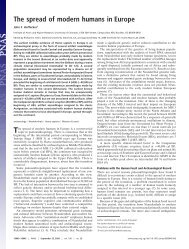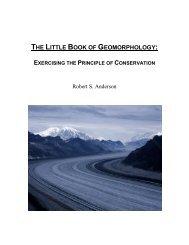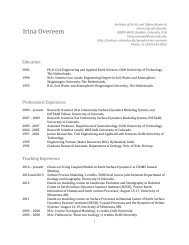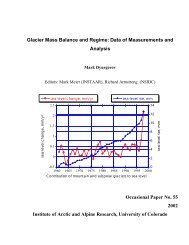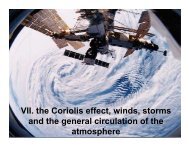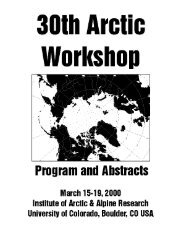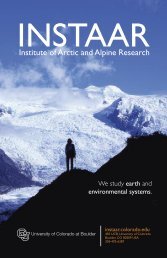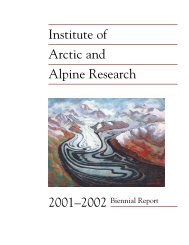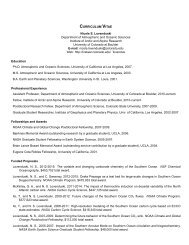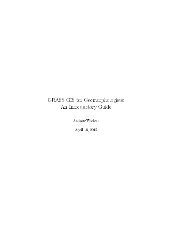access environment within the CU domain, protected by afirewall, connected to a 1<strong>00</strong> Mpbs LAN network throughCU’s network tied in to the NCAR, NOAA, NIST high performancecomputing system. These multi-processor servershave 24 hour on-site support, and use an APC 16K UPSwith a 20-minute uptime in case <strong>of</strong> a power failure, to allowfor proper shutdown during longer power outages. The ECIFacility supports many other computers, servers, andperipherals (DVD/CD ROMS and burners, disk and tapedrives, B&W and color LaserJet printers, color scanners, HPDesign Jet 5<strong>00</strong>0PS 60" plotter, video-out digital camera, andLogitech 3-D visualization tools).HerbariumThis facility is housed at the Mountain Research Station. Itcontains a field collection <strong>of</strong> plants <strong>of</strong> the Front Range, specializingin plants <strong>of</strong> Niwot Ridge and environs.ICP-MS Trace ElementLaboratoryThis facility houses a Thermo Finnigan Element2 inductivelycoupled plasma mass spectrometer (ICP-MS) for the measurement<strong>of</strong> trace and minor elements in carbonates, naturalwaters, and other materials. A Class 1<strong>00</strong>0 clean room isused for sample preparation. The laboratory is directed byTom Marchitto.Kiowa Environmental ChemistryLaboratoryThis laboratory is the environmental chemistry laboratoryfor the Niwot Ridge/Green Lakes Valley Long-TermEcological Research Program. The laboratory is located atthe Mountain Research Station and is managed by ChristineSiebold and directed by Mark Williams. Equipped with anion chromatograph, a spectrophotometric flow injectionanalyzer, a spectrophotometric segmented flow analyzer,and an atomic absorption spectrometer, the laboratory analyzesair, snow, water, and soil samples collected by facultyand graduate students from alpine and sub-alpine ecosystemsfor major solutes and nutrients.Landscape Ecology andConservation LaboratoryThis laboratory conducts basic and applied research in threemain areas: the ecology, distribution, and conservationplanning <strong>of</strong> species, vegetation types, and ecosystems; multiscaledanalysis <strong>of</strong> treeline structure, composition, anddynamics; and more recently, the analysis <strong>of</strong> interactionsbetween environmental and social dynamics, including forecastingthe effects <strong>of</strong> these interactions on patterns <strong>of</strong>dynamic changes and the ecological resilience <strong>of</strong> complexsocioecological systems. Research to date has focused onthe development and prototyping <strong>of</strong> methods and techniquesfor integrated regional ecological assessments,ecosystem characterization and regionalization mapping <strong>of</strong>ecosystem units, modeling <strong>of</strong> plant species and vegetationtype distributions, landscape analysis <strong>of</strong> ecotones at thealpine treeline, and integration <strong>of</strong> ecological knowledge intothe planning process. Recent work has included integratingdifferent technologies (modeling, GIS, remote sensing,development <strong>of</strong> knowledge bases, and reserve selectionalgorithms) to design regional networks <strong>of</strong> conservationreserves. Study areas include the western United States,with special emphasis on Colorado, the Pacific Northwest,and Southwestern regions, and western Europe. The laboratoryis directed by Patrick Bourgeron and managed by HopeHumphries.Limnology LaboratoryThis is an analytical laboratory for studying water and sedimentsamples. The laboratory is equipped for sample preparation,analysis <strong>of</strong> metals and major cations using the atomicabsorption spectrophotometer, and the preparative isolation<strong>of</strong> organic fractions using column chromatography. Thelaboratory is directed by Diane McKnight and is used bypostdocs, graduate students, and undergraduate studentsenrolled in McKnight’s classes.Micropaleontology LaboratoryThis is a foraminiferal analysis laboratory equipped withsieves and other equipment needed for preparation <strong>of</strong>foraminiferal samples, and binocular microscopes, faunalreference slides, and books for foraminiferal assemblageanalysis and picking <strong>of</strong> stable isotope and radiocarbon samples.An image analysis facility employing a binocular microscope,analog camera, and computer is available to allresearchers or students for computer imaging <strong>of</strong> foraminifers,plant macr<strong>of</strong>ossils, mollusks, beetles, and other macr<strong>of</strong>ossils.The laboratory is managed and supervised by AnneJennings.Oceanography LaboratoryThe purpose <strong>of</strong> this laboratory is to develop and deploymarine instruments related to understanding sedimentdynamics. Major equipment includes an underwater camerasystem for studying flocculation dynamics, a CTD, an attenuancemeter, and a LISST (in situ laser particle size analyzer).The laboratory also houses an extensive geophysicaldata library <strong>of</strong> analog and digital seismic and sidescan datafrom glacimarine environments. James Syvitski and EricHutton are in charge <strong>of</strong> the laboratory.Palynology LaboratoriesThese laboratories comprise two pollen sample preparationlaboratories and a pollen microscopy laboratory. The samplepreparation laboratories have standard equipment for chemicalpretreatment <strong>of</strong> sediment samples for micropaleontologicalanalyses <strong>of</strong> pollen and diatoms. The microscopy laboratoryhas two high-powered, research-grade light microscopeswith image analysis capabilities, several light microscopesfor student use, and a binocular microscope with18 | RESEARCH MISSION
camera equipment. These laboratories are supervised bySarah Spaulding.Quaternary GIS LaboratoryThis facility applies state-<strong>of</strong>-the-art tools and concepts withGeographic Information Systems (GIS) and remote sensingto a variety <strong>of</strong> environmental problems at high latitudes.Quantitative spatial analysis focuses on shoreline erosion inAlaska, as well as past and present glacier dynamics andice-field archaeology. Activities also support geospatial datasharing, community planning for Arctic GIS, online mappingtechnologies, and a variety <strong>of</strong> outreach. Other projectsinvolve graduate students with studies <strong>of</strong> paleoclimate,paleolimnology, and geomorphology from Australia toIceland. Under the direction <strong>of</strong> William Manley, and withGIS/RS Specialist Leanne Lestak, the lab includes four workstations,a large-format scanner, peripherals, and a range <strong>of</strong>s<strong>of</strong>tware (ArcGIS, Imagine, ENVI, and others).Sample Preparation Laboratory,Mountain Research StationField collected soils and plants are dried, extracted,weighed, and filtered in this lab found in the John W. MarrBuilding at the MRS. Equipment includes drying ovens,shakers, filter manifolds, and gas exchange systems for plantand soil CO 2 exchange.Sedimentology LaboratoryThis laboratory provides high-quality data for research projectsfor <strong>INSTAAR</strong> Directorate members, postdocs, graduateand undergraduate students, and outside clients. The laboratoryperforms both chemical and physical analyses onsediments and other material and encourages students torun their own analyses. The lab is equipped to measuregrain size using a laser diffraction particle size analyzer(Malvern long bed mastersizer), total carbon and inorganiccarbon content (Coulometer), magnetic properties (MS,SIRM, and IRM), bulk density and mineralogy (SiemensD5<strong>00</strong>0 X-ray Diffractometer). Sieves are available for bothdry and wet sieve analysis. The lab is equipped with ovens,two freeze dryers, a distilled water system, and analyticalbalances. The laboratory is coordinated by Wendy Roth,under the supervision <strong>of</strong> Suzanne Anderson.Snow and Ice LaboratoryThis laboratory is built around a 4<strong>00</strong>-square-foot cold room,with facilities presently configured for experimental work inheat and mass transfer in snow as well as general electronicsand mechanical design and fabrication. The laboratory isdirected by Tad Pfeffer.Stable Isotope LaboratoryThis laboratory is a state-<strong>of</strong>-the-art analytical facility thatuses stable isotopes to understand the processes controllingenvironmental change on time scales relevant to humaninteractions with the environment. The research focuses onthe modern carbon and water cycles and paleoclimaterecords from ice cores, lake sediments, carbonates, andorganic matter. The laboratory houses 9 mass spectrometersand 12 gas preparation systems for analysis <strong>of</strong> stable isotopes<strong>of</strong> oxygen, hydrogen, carbon, and nitrogen. The labshares a strong collaboration with the NOAA ClimateMonitoring and Diagnostic Laboratory, and analyzes isotopesin thousands <strong>of</strong> weekly samples <strong>of</strong> greenhouse gasesfrom a global network. The lab is currently analyzing samplesfrom major ice core pr<strong>of</strong>iles in Greenland andAntarctica. The stable isotope laboratory is supervised byJim White, managed by Bruce Vaughn, and utilizes a staff<strong>of</strong> five technicians, numerous graduate students, and postdocsto analyze over 48,<strong>00</strong>0 samples per year.Trace Organic GeochemistryLaboratoryResearch in this laboratory is focused on quantitative reconstructions<strong>of</strong> past sea-surface temperatures and applications<strong>of</strong> organic geochemistry to problems in paleoclimatologyand carbon cycle science. Major equipment includes traceorganic clean preparation facilities, automated pressurizedfluid extraction (Dionex ASE 2<strong>00</strong>), automated solid phaseextraction (Gilson ASPEC XLi), gas chromatograph (HP6890 with 1<strong>00</strong>-position autosampler, programmable temperaturevaporization [PTV] inlet, and FID). This laboratory isdirected by Scott Lehman.The Pico Mountain AtmosphericObservatory after an icing storm,Azores, Spring 2<strong>00</strong>5. <strong>INSTAAR</strong>’sAtmospheric Research Laboratoryis continuing research on atmospherictransport and chemicalprocessing in the North Atlantic.Photo: Detlev Helmig(<strong>INSTAAR</strong>).Bruce Vaughn (<strong>INSTAAR</strong>)explains how ice cores fromAntarctica have recorded variationsin climate for hundreds <strong>of</strong>thousands <strong>of</strong> years, <strong>INSTAAR</strong>Open House, April 2<strong>00</strong>6. Suchvariations help put present climatechanges into a long-termperspective. Vaughn’s audiencewas a group <strong>of</strong> students fromSouthern Hills Middle School.Photo: Casey A. Cass (<strong>University</strong><strong>of</strong> Colorado).RESEARCH MISSION | 19
- Page 1 and 2: INSTAARInstitute of Arctic and Alpi
- Page 3 and 4: BiennialReport2005-2006Institute of
- Page 5 and 6: INSTAAR: An Earth andEnvironmental
- Page 7 and 8: CU-Denver campus where she helped t
- Page 9 and 10: Where in the world is INSTAAR? Acti
- Page 11 and 12: The instrument was deployed on NOAA
- Page 13 and 14: altered by humans over the past 200
- Page 15 and 16: ties. However, manmade reservoirs a
- Page 17 and 18: Arctic WorkshopThe annual Arctic Wo
- Page 19: Wendy Roth (INSTAAR) explains the p
- Page 23 and 24: Research Grants: Fiscal Years2004-2
- Page 25 and 26: Ogilvie, Astrid: NSF. HSD: Human an
- Page 27 and 28: Theses Completed2005Breiter, Nehale
- Page 29 and 30: Gifford MillerGEOL 1060, Global Cha
- Page 31 and 32: Lana Cohen, MS, Atmospheric and Oce
- Page 33 and 34: Trevor Popp, PhD, Geological Scienc
- Page 35 and 36: Societal Outreach andInformal Educa
- Page 37 and 38: A group of students from Southern H
- Page 39 and 40: Outreach SpotlightsUNDERGRADUATE ME
- Page 41 and 42: Spotlights: Honors, Awards,and Reco
- Page 43 and 44: TIM SEASTEDT WINS THE 2005PACESETTE
- Page 45 and 46: Structure of hierarchically organiz
- Page 47 and 48: William F. ManleyFellow of INSTAAR.
- Page 49 and 50: Alan R. TownsendFellow and Associat
- Page 51 and 52: GeophysicsEdmund AndrewsChief River
- Page 53 and 54: INSTAAR Visiting Scientists,2005-20
- Page 55 and 56: Chris JarosSupervisor: Diane McKnig
- Page 57 and 58: INSTAAR Noon SeminarsSpring 2005Tad
- Page 59 and 60: Graduate Student TalksSpring 2005Ry
- Page 61 and 62: Journal and BooksArctic, Antarctic,
- Page 63 and 64: Publications2005Adams, P. N., Storl
- Page 65 and 66: “El Nino suppresses Antarctic war
- Page 67 and 68: European settlement of Lake Eyre, S
- Page 69 and 70: tion of Baffin Island, Arctic Canad
- Page 71 and 72:
and soil quality for sustainable gr
- Page 73 and 74:
Andrews, J. T., Eberl, D. D., and K
- Page 75 and 76:
Cleveland C. C., Reed S. C., and To
- Page 77 and 78:
and Pierre Y. Julien. Journal of Hy
- Page 79 and 80:
Tributaries to the ColoradoRiver th
- Page 81 and 82:
Rocchi, S., LeMasurier, W. E., and



